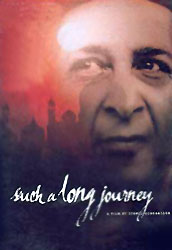 Such a long journey unfolds the tale of the common Bombayites. Gustad , his life, his daily hard work and indeed the inviolable background of the Indo Pak war forms the base of the story.
Such a long journey unfolds the tale of the common Bombayites. Gustad , his life, his daily hard work and indeed the inviolable background of the Indo Pak war forms the base of the story.
Rohinton Mistery was born on 3rd July 1952. He is considered to be one of the famous authors who have gone out of India and writing in English. Rohinton Mistry is of Indian origin, he belongs to the Parsi Zoroastrian religious minority. The Parsis are small, yet united, religious community in India, devoted to Zoroastrianism, whose ancestors fled Islamic persecution in Iran during the eighth century. At his young age he worked in a bank for some days. After completing his degree in English and philosophy he attended University of Toronto where he won two Hart House literary prizes and Canadian Fiction magazine`s annual contributor`s prize for 1985. His first novel `Such a long journey` was published in 1991. This creation of Mistry won many awards e.g. Governor general`s award, commonwealth writer`s prize for best book, W. H. Smith books in Canada first novel award. The novel has also been translated in German, Swedish, Norwegian, Danish and Japanese. This story of the author has also made into a film sharing the same name as the novel `Such a long Journey`.
Synopsis:
Rohinton Mistry uses `ordinary` men and women as his protagonists and fills his novels with the sights, sounds, smells, and color of India. Depicting his characters as neither saints nor sinners, he involves the reader in their lives as they try to survive the complexities of their culture. The backdrop of `Such a Long Journey` is set in Bombay and the time is 1971. The central character of the novel is very hard-working bank clerk named Gustad Noble. He is a devoted family man. He works hard to maintain his family properly. She has Dilnavaz, his wife and three children in his family. But there comes some problems in his life when his eldest son Sohrab refuses to attend the prestigious Indian Institute of Technology to which he has gained admittance. His youngest daughter Roshan falls ill. Other conflicts within the novel involve Gustad`s ongoing interactions with his eccentric neighbours and his relationship with his close friend and co-worker, Dinshawji. A letter that Gustad receives one day from an old friend, Major Bilmoria, slowly draws him into a government deception involving threats, secrecy and large amounts of money. Throughout the novel, the wall outside Gustad`s apartment building symbolizes the larger world of Bombay and parallels some aspects of Gustad`s own life. At the outset, it is used as a latrine, breeding illness in the neighborhood. Gustad tries something to come out of this problem. He persuades a sidewalk artist to paint it, and consequently he depicts scenes from all the religions of India. In this way the wall becomes a holy place. Eventually the government decides to widen the road and tear it down.
Being published by Mc clelland and stewart, Random house Inc., Alfred a Knopf, Faber and Faber, `Such A Long Journey` has been made into a movie named Such a long journey which was released in the year of 1998.
`Such A Long Journey` by Rohinton Mistery is a marvelous collection illustrating day to day life in a unique way. It is a beautifully constructed and emotionally involving story of a small family trying to live meaningful lives against almost overwhelming odds. The characters are finely drawn, and the plot reflects the traumas of an ordinary man and his wife caught up in events and crises not of their own making. This novel unable the author to take the experience of writing and become well versed in career.













